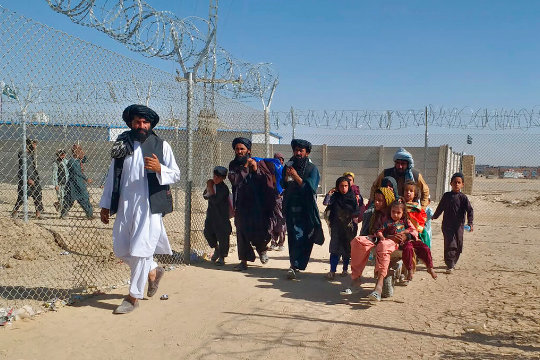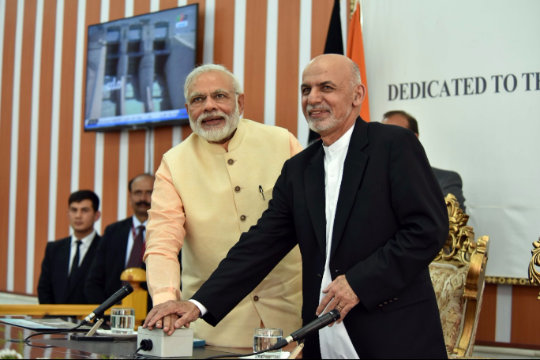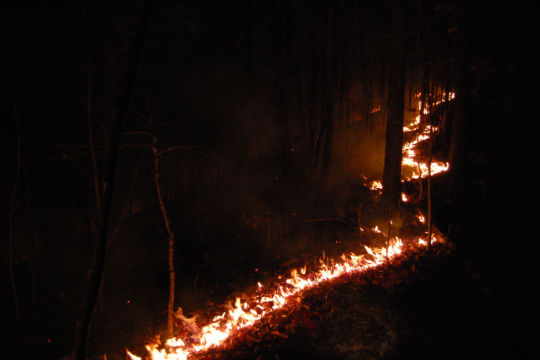| September 03, 2021 | dri.thediplomat.com |
| Afghan Aftershocks | ||||||||
|
Welcome to the newsletter of Diplomat Risk Intelligence, the research and consulting division of The Diplomat, your go-to outlet for definitive analyses from and about the Asia-Pacific. This week’s edition continues DRI’s coverage of the Afghanistan crisis. We delve into its humanitarian dimension and explore how the international community, the United Nations in particular, is responding to what – by many measures – could amount to an across-the-board catastrophe for the Afghan people. We continue to monitor how countries in eastern Asia-Pacific are responding to the return of the Taliban to Kabul, as well as South Asian apprehensions about the development. Finally, we suggest that self-organized criticality may be a good way to think about the developments of August 15. | ||||||||
Afghanistan Stares at Humanitarian Abyss | ||||||||
| Afghan families enter into Pakistan through a border crossing point in Chaman, Pakistan, Sunday, August 22, 2021. | ||||||||
| — AP Photo, Jafar Khan | ||||||||
After a twenty-year hiatus, the Taliban have returned to power in Afghanistan declaring their “war is over.” The last American soldier has left Afghan soil under ignoble conditions, most countries have evacuated their diplomatic staff, and some countries are considering conditional diplomatic recognition of the Taliban government—which is now in its "final stages" of formation. Amidst these dystopian developments, the question that continues to agitate the international community’s imagination is: what now? A U.N. report warns that Afghanistan is on its course to witness the “highest ever number of documented civilian causalities” in a single year since its assistance mission in the country began operations in 2002. In the first half of this year, the U.N. reported 5,183 civilian casualties—a 47 percent increase over the same period last year. Despite the Taliban’s repeated reassurances that it will contain violence and vows to be accountable to the Afghan people, ground reports suggest otherwise, increasing fears of a gap between their words and actions. Several Afghan citizens who are reportedly on the Taliban’s “blacklist” are being targeted through the Taliban’s door-to-door searches and probes of social media accounts. The deteriorating situation in Afghanistan has brought the country to the brink of a major humanitarian crisis, leaving humanitarian relief providers, including the U.N. and its agencies, deeply overwhelmed. World Health Organization Regional Director for the Eastern Mediterranean Dr. Ahmed Al-Mandhari has warned against “delays and disruptions” to Afghan’s healthcare as it could leave the most vulnerable groups from seeking life-saving health care. He has also reiterated the “immediate need” to ensure “continuity of health services across the country.” Despite the viral images showing planes packed with Afghan people fleeing the country, the harsh reality is that majority of Afghans are still inside, unable to leave through regular, official, channels. As it stands, the number of internally displaced people has crossed 570,000—80 percent of whom are women and children. Most of them come from five of Afghanistan’s 34 provinces: Junduz, Bamyan, Badghis, Nagarhar, and Takhar. Hunger and malnutrition have spiked, with the U.N. World Food Programme (WFP) chief warning that WFP will start to run out food in September absent additional funding. Above all, Afghanistan’s already fragile economy – heavily dependent on aid -- is on the brink of collapse with the value of the Afghani declining to a record low in the past few weeks. Prices of staples such as flour, oil and rice have risen by 10 to 20 percent in the past few days and people lost their jobs overnight. Rampant cash shortage and closed banks have exacerbated the Afghan people’s misery. Washington has frozen nearly $9.5 billion in assets belonging to the Afghan central bank, and has stopped all cash flow into the country, thus virtually stopping the flow of remittances into the country. The fast-moving Afghanistan crisis has caught the attention of the United Nations, with repeated appeals from Secretary General António Guterres to the international community to “stand as one.” An emergency U.N. Security Council meeting was held the day after the Taliban captured Kabul on August 15, and passed a resolution which called for “establishment, through inclusive negotiations, of a new government that is united, inclusive and representative…” and an immediate end to the violence in the country. In a recent meeting, member countries adopted a resolution demanding that Afghanistan not be used to threaten or attack any nation or shelter terrorists, while reiterating the need to combat terrorism in the country. Although the resolution called upon “donors and international humanitarian actors” to provide humanitarian assistance to Afghanistan and major refugee-hosting countries, no concrete plan to address the ongoing human rights abuse in the country was adopted. China and Russia abstained from voting; according to the Russian permanent representative to the U.N., this was because certain “principled concerns” were not reflected in text. The U.N. has a rather checkered history when it comes to the political response to the Afghanistan conflict, which has, in turn, affected its humanitarian operations in the past. In the post-Taliban reconstruction of Afghanistan, the U.N. undertook several initiatives to develop an “ambitious state-building process, aimed at reforming and rebuilding the country” adopting a “light footprint” approach as opposed to its other peace operations. The U.N. has no peacekeepers on the country, and the India’s permanent representative to the U.N. has clarified that the Security Council is not considering a peacekeeping force for Afghanistan in the current situation, despite repeated calls for the same from women’s rights supporters and faith leaders. (India held the presidency of the Security Council during August.) The World Bank has “paused” disbursements to its operations in Afghanistan, just a week after the International Monetary Fund halted Afghanistan’s access to its funds. Several European countries have halted development aid for Afghanistan, including Germany which had previously agreed to provide $506 million in aid to Afghanistan, making it one of the biggest donations to the country. The sudden absence of funds has brought Afghanistan’s healthcare system at the brink of collapse, especially because of the significant increase in demand on the system but lack of facilities and supplies to meet them. The European Union’s recent announcement to ramp up its Afghan aid program and the U.S. decision to allow humanitarian work to continue despite sanctions on the Taliban, is a step in the right direction. But a lot more needs to be done to protect aid workers in the country who are especially vulnerable under the Taliban regime. | ||||||||
South Korea Takes in Afghan Refugees | ||||||||
| Afghans, who worked for South Korea-run facilities in Afghanistan, and their family members walk through the terminal before boarding a bus after they arrived at the Incheon International Airport, South Korea, Thursday, August 26, 2021. | ||||||||
| — AP Photo, Ahn Young-joon | ||||||||
According to the United Nations High Commissioner for Refugees situational update released on September 1, an estimated 16,500 newly-arrived Afghan refugees approached the agency and its partners in neighboring countries since the beginning of the year. Currently, roughly 90 percent of the world’s Afghan refugees are hosted in Iran and Pakistan, and reports suggest a steady flow of Afghans approaching border posts with Pakistan. Although more than more than 114,000 Afghans were able to flee their country through American and European evacuation efforts, many of them remain stranded in Doha. Ninety eight countries have pledged to accept Afghan refugees, but since there are currently no commercial flights flying out of Afghanistan, Afghans are relying on land routes to seek asylum in neighboring countries.
Among the 98 is South Korea, which received 378 Afghans – individuals who had worked at the country’s embassy and other facilities in Afghanistan, and their family members – on August 26. South Korea has extended a warm welcome to the newcomers, designating them “persons of special merit,” and not refugees. Commenting on the development, an editorial in Dong-a Ilbo, a leading South Korean newspaper, said on August 28: “It is impossible [for South Korea] to turn a blind eye to its Korean friends in crisis.” The editorial went ahead to describe the relocation of the Afghans to South Korea as part of the country’s obligations that follow from its growing international reputation. It also pointed to the significance of the event, noting that this was the first time South Korea has accommodated a large number of foreigners from conflict zones. Meanwhile, the events of August 15 and its aftermath continue to remain firmly in focus elsewhere in the Asia-Pacific. An August 28 editorial in Yomiuri Shimbun, a major Japanese newspaper, laid the blame for the chaos in the Kabul airport on the United States. Commenting on the August 26 attack on the airport by Islamic State affiliates in Afghanistan, the newspaper opined: “The United States is obligated to provide a military force and equipment to ensure that foreign nationals and allies can leave the country safely.” “[U.S. President Joe] Biden must acknowledge the incompleteness of [his withdrawal] strategy and reorganize the effort in collaboration with U.S. partners, including NATO allies such as the U.K., France and Germany,” it added. | ||||||||
Report: Afghanistan and the Taliban’s Return In a two-part report based on exhaustive in-house research and multiple expert consultations, DRI examines the international security, political, economic, and social equity implications of the Taliban’s return to power. The report also presents a pre-August baseline assessment of these issues for the 2001-2021 period, and possible differences in the Taliban’s current positions on these issues from the past. | ||||||||
Afghanistan and South Asia: Exploring the Known Unknowns | ||||||||
| Indian Prime Minister Narendra Modi and former Afghan President Ashraf Ghani at the inauguration of the Afghan-India Friendship Dam, June 14, 2016 | ||||||||
| — Flickr, Narendra Modi | ||||||||
What does the Taliban’s return mean for the India-Pakistan rivalry? To what extent will China go to engage the Taliban given its own security concerns? Can China use Pakistan to shape the Taliban’s behavior? What impact will the rise of Taliban have on the Islamist insurgency in smaller South Asian countries such as Bangladesh? These were some of the pressing questions addressed by South Asian security expert Dr. Avinash Paliwal in the latest episode of DRI Future Tense. While discussing India’s historic discomfort with the Taliban, Paliwal attributes it largely to New Delhi’s fears that the group’s victory will embolden radical Islamists, especially in the volatile Jammu and Kashmir region, compromising India’s own national security. He provides a historic overview on how the Pakistan-Taliban patron-client relationship has evolved and offers some unique insights into how it is likely to change, given the Taliban’s attempts to diversify ties, including with India. Although Pakistan continues to hold several leverages over the Taliban, including through familial, religious, and business links, Paliwal asserts that it is unlikely to be able to micromanage the Taliban going forward, as it had done in the past. He also discusses some of the ideological and operational challenges Beijing faces in the wake of a more violent Afghanistan, and how its deep economic relationship with Pakistan makes it more vulnerable. Unlike in Myanmar where China has adopted a bottom-up approach to secure its interests, Beijing is likely to struggle to secure investments in the much more complex Afghan-Pakistan corridor, Paliwal assesses. Listen to the full episode here. | ||||||||
| ||||||||
Self-Organized Criticality | ||||||||
| — Flickr, Nahh | ||||||||
During the course of an interview for an upcoming two-part DRI report on Afghanistan and the return of the Taliban, an expert noted that the fall of Kabul on August 15 represented a “tipping point” – a phase transition, in the language of physics, due to the interaction of a number of factors, big and small. The expert pointed at Afghanistan’s kleptocratic political culture, former President Ashraf Ghani’s polarizing political style and penchant for centralization of power, the demoralizing effect that the United States’ legitimization of the Taliban through the February 2020 Doha agreement had on the Afghan government and the military, and finally, latent weaknesses of the Afghan security forces as all having contributed to what looked like an abrupt collapse of the republican regime in Kabul. In the language of theoretical physics, on August 15 Afghanistan was at a critical state, as it phase-transitioned from the old post-2001 U.S.-managed order to one led by the Taliban – an order whose contours are yet to become clear. Largely due to the pioneering work of the physicist Per Bak, we now know how systems (physical, biological, and even social and economic) on their own change phase due to very many local interactions (each insufficient on its own) – as opposed to needing steering, such as what happens when you turn ice into water by adding heat from the outside. This “self-organized criticality” perspective was once much in vogue, and has been used to explain everything from forest fires and earthquakes to stock market crashes and the onset of the First World War. But in the recent years, it has been subsumed by more powerful conceptual tools. Nevertheless, it remains a very nifty way of thinking about things. | ||||||||
DRI’s Director of Research Abhijnan Rej and Research Analysts Malvika Rajeev and Rushali Saha contributed to this edition of DRI Asia Review. Translations of Japanese and South Korean media articles were provided by an in-house team of linguists. | ||||||||
Diplomat Risk Intelligence (DRI) is the research and consulting division of The Diplomat, the Asia-Pacific’s leading current affairs magazine. Learn More | ||||||||
For DRI services, contact us at: | ||||||||
Follow The Diplomat on:
| ||||||||
| This newsletter was sent to [[EMAIL_TO]]. Unsubscribe | ||||||||
| Diplomat Media Inc. | 1701 Pennsylvania Ave | Washington, D.C. 20006 | USA | ||||||||
| [email protected] | thediplomat.com | ||||||||
| ©2021 Diplomat Media Inc. All rights reserved. | ||||||||









